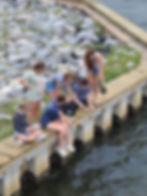





Our student led Aquatic Care Team (ACT), is currently monitoring the water quality in the area. The team monitors water quality at several sites in the Santa Rosa Sound and samples for Red Tide in the Gulf. The Aquatic Care Team began with a grant from NOAA's B-WET program, which supports student learning through local environmental education projects. The Aquatic Care Team has also received funding from the Pensacola and Perdido Bay and Esutary Program, which is committed to restoration and preservation of the Pensacola Bay and Perdido Bays.
We have worked to establish a GIS system for our data reporting. If you would like to view our most up-to-date data, please click below to visit our data site.
Estuary Monitoring

As part of our estuary monitoring program, students learn the importance of water quality for this fragile ecosystem. Estuaries like the Santa Rosa Sound play a crucial role as a habitat for juvenile fish and a buffer zone between the land and sea. their unique position also makes them particularly vulnerable, though, to human impacts due to increased development, pollution, and recreational use.
Through our water quality program, students learn exactly how humans impact this ecosystem and what steps we can take to protect our estuary. They are then able to share their knowledge within the community.
The monitoring program also gives students hands-on experience in using field equipment, collecting and inputting data, and performing tests in the lab. Students are then more prepared for lab work and research experiences when they move on from the program.


Red Tide Monitoring


Students use a HABscope, which is a low-cost portable microscope system developed by the Gulf of Mexico Coastal Ocean Observing System (GCOOS) that uses AI and other technologies to automatically detect the presence of Karenia brevis in water samples. (K. brevis is the organism that causes red tides in the Gulf of Mexico.)
Read more about students' work with GCOOS and the HABscope here.

Microplastic Research







